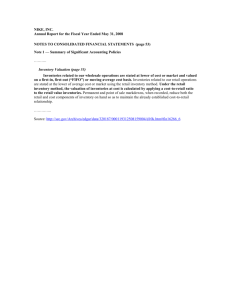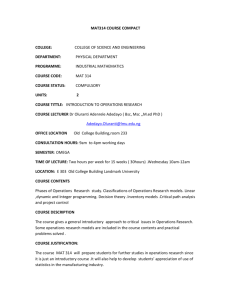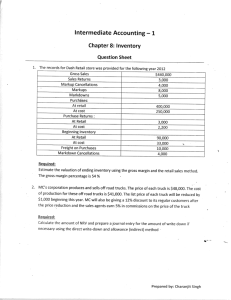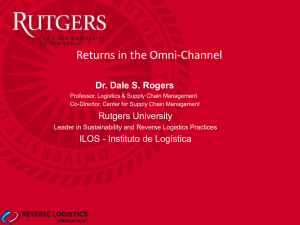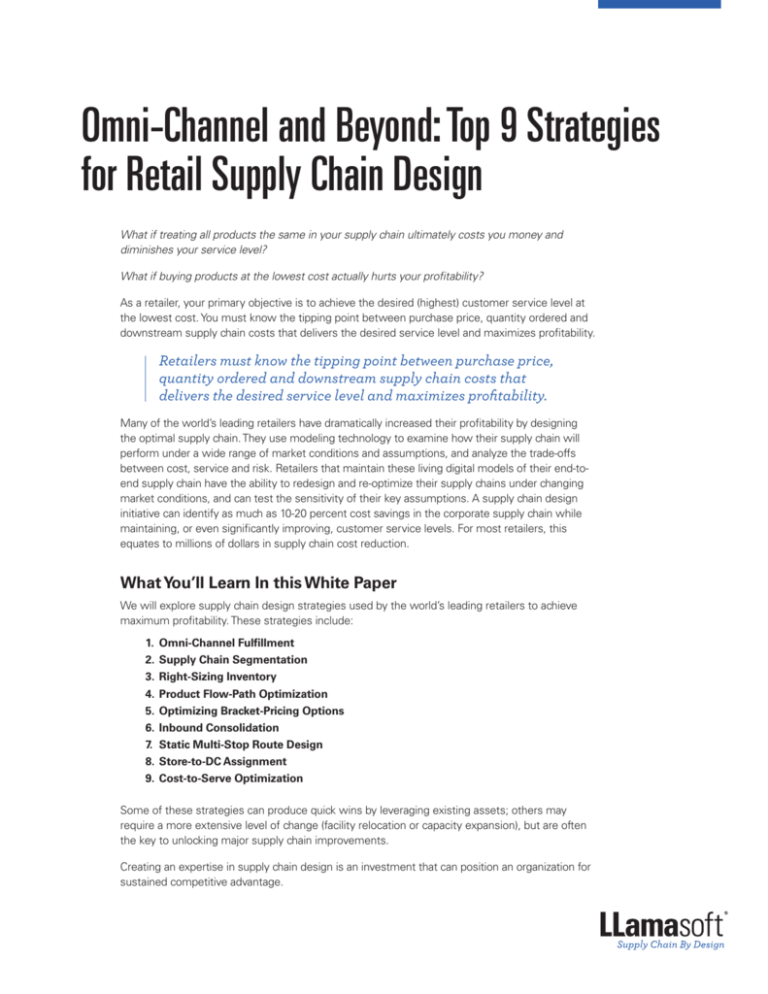
Omni-Channel and Beyond: Top 9 Strategies
for Retail Supply Chain Design
What if treating all products the same in your supply chain ultimately costs you money and
diminishes your service level?
What if buying products at the lowest cost actually hurts your profitability?
As a retailer, your primary objective is to achieve the desired (highest) customer service level at
the lowest cost. You must know the tipping point between purchase price, quantity ordered and
downstream supply chain costs that delivers the desired service level and maximizes profitability.
Retailers must know the tipping point between purchase price,
quantity ordered and downstream supply chain costs that
delivers the desired service level and maximizes profitability.
Many of the world’s leading retailers have dramatically increased their profitability by designing
the optimal supply chain. They use modeling technology to examine how their supply chain will
perform under a wide range of market conditions and assumptions, and analyze the trade-offs
between cost, service and risk. Retailers that maintain these living digital models of their end-toend supply chain have the ability to redesign and re-optimize their supply chains under changing
market conditions, and can test the sensitivity of their key assumptions. A supply chain design
initiative can identify as much as 10-20 percent cost savings in the corporate supply chain while
maintaining, or even significantly improving, customer service levels. For most retailers, this
equates to millions of dollars in supply chain cost reduction.
What You’ll Learn In this White Paper
We will explore supply chain design strategies used by the world’s leading retailers to achieve
maximum profitability. These strategies include:
1. Omni-Channel Fulfillment
2. Supply Chain Segmentation
3. Right-Sizing Inventory
4. Product Flow-Path Optimization
5. Optimizing Bracket-Pricing Options
6. Inbound Consolidation
7. Static Multi-Stop Route Design
8. Store-to-DC Assignment
9. Cost-to-Serve Optimization
Some of these strategies can produce quick wins by leveraging existing assets; others may
require a more extensive level of change (facility relocation or capacity expansion), but are often
the key to unlocking major supply chain improvements.
Creating an expertise in supply chain design is an investment that can position an organization for
sustained competitive advantage.
LLamasoft – Omni-Channel and Beyond: Top 9 Strategies for Retail Supply Chain Design
Strategy 1: Omni-Channel Fulfillment
E-commerce giants like Amazon have raised the bar for on-line
fulfillment, leading customers to expect rapid delivery, free
shipping and free returns when they place an online order.
Omni-channel fulfillment strategies can provide a new level of service and convenience for retail
customers. The retailer’s objective is to utilize a variety of fulfillment locations in order to provide
a smoother customer shopping experience, improved service time and inventory levels and
lowered overall cost.
Business Challenge:
Supply chain design solutions such as network optimization and
greenfield analysis can help identify strategies for improving store
sourcing and inbound transportation costs based on required service constraints. It is also useful to understand how to optimally
leverage e-commerce, brick and mortar and third-party channels to minimize overall costs while
meeting unique demands in each channel. Multi-echelon inventory optimization can provide a full
inventory plan that right-sizes inventory levels across echelons to meet service requirements at
lowest overall cost.
Supply Chain
Design Solution:
A large department store chain wanted to design an effective
one-day and second-day delivery fulfillment network for its
growing e-commerce channel. This included determining the
optimal number, location and size for fulfillment centers as well as best way to flow merchandise
through the network to customers. Utilizing network optimization and greenfield analysis, the
company built an eight-year plan to expand capacity by establishing new facilities and incrementally
increasing existing capacity as needed.
Case Example
The analysis considered costs and service times of UPS and FedEx standard service, next day service and second day service as well as zone skipping strategies. The resulting plan leveraged retail
stores to meet peak season demand and as a method of satisfying local market demands where
fulfillment center delivery time and/or total network costs may exceed local fulfillment costs. The
project also analyzed potential regional store fulfillment options which would enhance store fulfillment
efficiencies and potentially direct demand to the local store as the first path for fulfillment.
Image 1
2
© 2013 LLamasoft, Inc. All rights reserved.
LLamasoft – Omni-Channel and Beyond: Top 9 Strategies for Retail Supply Chain Design
Strategy 2: Supply Chain Segmentation
Many retailers offer as broad a variety of stock keeping units
(SKUs) as possible to ensure that their customers’ demands are
met. However, customers’ buying patterns vary greatly based on
product size or color, geographic region, price, season and availability. Many retail organizations
ignore these unique buying patterns and operate with a single product flow through a single,
fixed supply chain network structure. Some organizations exacerbate the problem by instituting
a single stocking strategy for all products. This can lead to stock-outs on key high-demand or
high-margin items while simultaneously carrying too much stock on under-performing items.
Business Challenge:
A supply chain segmentation, or categorization study, is an
excellent method to determine where your supply chain should
be differentiated to better suit individual product stocking and
delivery needs. By examining key product characteristics, such as
margin, velocity and variability, you can spot trends and “clusters” of like-products, e.g., slow
versus fast movers or low margin/high demand products. Each cluster may require different buying
and supply chain strategies, e.g., setting unique service and inventory targets or delivery methods.
You can model, test and implement unique strategies for each supply chain product segment to
achieve the optimal stocking and delivery performance at the lowest total operating cost.
Supply Chain
Design Solution:
A big-box retailer carries over 20,000 SKUs and flows all products
through a two-tier distribution network. A small number of
national distribution centers (NDC) consolidate inbound supplier
shipments. These NDCs consolidate products and ship them to regional distribution centers (RDC),
each of which supplies an assigned set of stores. A three-dimensional plotting of product velocity,
margin, and demand variability led the retailer to identify 10 unique supply chain segments.
Case Example
IMAGE 2: Depiction of product
groups by margin and velocity. The
cluster of products in the upper-right
hand quadrant (blue) are high-margin/
high-velocity products. Products in the
lower-left hand quadrant (green) are
Image 2
low-margin/low-velocity products.
Unique supply chain strategies were designed for each unique segment, for example:
3
On-shelf availability for high-volume and high-margin items was optimized, resulting in increasing revenue while reducing lost sales.
Inventory for low-volume and low-margin items was centralized in a few RDCs and
fewer of these items were stocked on store shelves, resulting in a reduction in cost.
Creating a new store-to-store transportation (transfer) capability for high-margin
items with high-demand variability resulted in out-of-stock items in one being available within one hour, lead to a reduction in lost sales and a simultaneous reduction in
inventory cost.
© 2013 LLamasoft, Inc. All rights reserved.
LLamasoft – Omni-Channel and Beyond: Top 9 Strategies for Retail Supply Chain Design
Strategy 3: Right-Sizing Inventory
Different products’ margins and velocity through the supply chain
vary greatly. Some products are much more important to your
profitability than others. Defining your supply chain segments can
lead you to make more effective decisions on service requirements or desired fill-levels for each
unique product category. However, the inherent variability of both customer demand and inbound
supply make it difficult to determine exactly how much inventory is enough. This problem is
complicated when the supply chain has multiple tiers and you must decide how much inventory
of each item to keep at each level.
Business Challenge:
Multi-echelon inventory optimization determines how much
inventory should be kept at each level and location in the supply
chain to deliver the desired service level at the lowest cost—
either by SKU or by category. This analysis accounts for the
inherent variability in both the demand and supply side to identify the lowest total cost inventory
stocking solution that meets the service requirements. In this approach, you define service
requirements for each product and site, e.g., “I want 99 percent availability for SKU #333 at my
Chicago store.” The inventory optimization technology then determines the minimum level of
product to be stocked at each echelon and location to meet these targets while minimizing the
total inventory holding costs.
Supply Chain
Design Solution:
A grocery store chain has seven regional distribution centers
that stock product for, and deliver to, over 500 stores throughout
the country. The top 1,500 SKUs are stocked at all DCs. These
represent more than 70 percent of the overall sales volume. The company established seven
service-level categories between 85 percent and 99 percent, based on product characteristics.
Case Example
A multi-echelon inventory optimization analyzed the demand and lead-time variability for each
product/site combination and recommended a $5M reduction in overall inventory, even though
numerous locations required a higher level of inventory. In specific cases, inventory for a product
was increased in three or four sites and decreased in others. The result was the “right-size”
inventory for the organization. Savings are achieved by actualizing the lowest total landed-costs
and not incurring excessive supply chain costs due to buying improper quantities.
IMAGE 3: Seven service-level categories with historical inventory stocking
level (depicted by the orange bar), the
newly-calculated and optimized stocking level (depicted by the green bar),
and the difference—either positive or
negative (depicted by the blue bar).
Blue bars extending below the line
imply a reduction in inventory and
those extending above the line imply
an increase in inventory level is optimum. The length of the bars depicts
the inventory level in millions of dollars.
4
© 2013 LLamasoft, Inc. All rights reserved.
Image 3
LLamasoft – Omni-Channel and Beyond: Top 9 Strategies for Retail Supply Chain Design
Strategy 4: Product Flow-Path Optimization
There are many variables that determine a product’s flow-path
from sourcing to the customer. These variables include the
supplier, the quantity purchased, the frequency of purchases
(with current bracket pricing as a given), the mode of transportation, the port-of-entry, the
distribution center, the transportation carrier, the transportation route and the order/ship time. All
of these variables imply that there are numerous “paths” along which a product can move from
its point of origin or manufacture to its ultimate retail point of sale.
Business Challenge:
Your objective is to maximize margin and
profit by determining the best flow-path
for each product that will yield the lowest
total landed cost and still meet the desired
service levels. This type of analysis provides a more accurate picture of
how each product should be supplied and distributed by accounting for
its unique characteristics. You can model product flows at the SKU or the
category level.
Supply Chain
Design Solution:
Image 4
before
Savings are achieved by determining the proper network configuration
to achieve the lowest total landed costs. Both right-sizing inventory and
product flow-path optimization impact total landed costs. Right-sizing
inventory determines how much and where; product flow-path optimization determines how to
flow product through the network.
A global consumer goods company wanted to evaluate how product
flowed from each of their 10 European plants to their customers in
Spain. Over 90 percent of all goods were flowing through a single
distribution center in Northeast Spain and were shipped by private over-theroad freight. While performing the product flow-path optimization, the team
added dozens of flow options, including new intermodal hubs, additional
distribution centers, inter-waterway and short-sea ports, and different
transportation modes (rail, short sea, inter waterways, and 3PLs). They also
Image 4
added service-level constraints to ensure that any solution would still meet
after
their strict customer service-level agreements.
Case Example
The variables created thousands of potential product flow-path options,
and the optimized answer defined the lowest total-landed-cost for each
product and production location. This solution showed that opening a
second facility in Central Spain, shifting over 50 percent of the volume to
the new DC, and utilizing significantly more rail transportation created the
optimal network. The additional facility operation costs, inventory holding
costs and handling costs associated with this new solution were offset by a significant reduction in
the overall transportation costs, giving the company a supply chain cost reduction of over €1.5M.
5
© 2013 LLamasoft, Inc. All rights reserved.
LLamasoft – Omni-Channel and Beyond: Top 9 Strategies for Retail Supply Chain Design
Strategy 5: Optimizing Bracket Pricing Options
Many retail merchandising organizations set up supplier “bracketpricing” agreements—tiered pricing agreements where purchasing
in larger quantities results in a better per-piece price. Many purchasing organizations are motivated and measured by their ability to achieve lower supply prices.
This incentive system often leads to an actual increase in a product’s total landed cost, due to
excess storage, handling and transportation costs. It is possible to have unnecessary and
avoidable supply chain costs actually exceed the savings
achieved through bulk purchasing. To optimize the
bracket-pricing option for each product, you must first
model the end-to-end supply chain costs to calculate the
true landed-cost.
Business Challenge:
In order to provide meaningful total landed cost
data to the procurement
team, you must first create a model of your end-to-end supply chain, incorporating all the costs incurred from the supplier(s) to the store
shelf. The supply chain model will likely then be locked in
place as a fixed network, potentially including alternative
policies for replenishment frequency, transportation mode/container, handling costs (for different
breakdown or stocking options), etc. At that point, the procurement analyst can enter the supplier
bracket pricing options and run the network optimizer to determine the correct purchase amount
and frequency that would deliver the lowest total landed cost.
Supply Chain
Design Solution:
A North American grocer’s sourcing group established bracketCase Example
price contracts with their suppliers, enabling them to get lower
per-piece prices when purchasing in larger quantities. (For
example, they could buy an item for $1.47/piece in a quantity of 1,000 units; the same item cost
$1.25/piece when purchased in a quantity of 10,000 units.) Since the buyers were incented to
reduce purchase costs, they would delay purchases or buy ahead in larger quantities to reduce
the total spend.
To evaluate their true landed-cost, the company modeled their end-to-end supply chain, including
source pricing, inbound and outbound transportation, warehousing costs, inventory holding
costs and transfer costs. Buyers were given an easy-to-use model to input their bracket purchase
amount and price options. The model provides the buyer with the optimal solution that minimized
the total landed-cost for each product purchase. This resulted in a total supply chain cost savings
of over $2M annually.
6
© 2013 LLamasoft, Inc. All rights reserved.
Image 5
IMAGE 5: Two total
landed-cost scenarios.
In #1, the product
is bought at a lower
price, but the total
landed-cost is higher
due to higher supply
chain costs. In #2, the
total landed-cost is
lower, even though the
purchase price of the
goods is higher.
LLamasoft – Omni-Channel and Beyond: Top 9 Strategies for Retail Supply Chain Design
Strategy 6: Inbound Consolidation
If each DC in your network replenishes individually, product costs
can be higher because individual DCs order smaller quantities
more frequently. Significant savings can be
garnered by establishing one DC (perhaps the one closest to the supplier)
as an inbound consolidation center. All shipments from the supplier are
delivered to that one DC and then appropriate quantities are transferred to
the other DCs as necessary.
Business Challenge:
Although this adds a second handling and transportation layer to the
distribution network and a redistribution cost, significant economies can
be realized due to utilizing transportation assets more efficiently and taking
advantage of vendor volume discounts. Pre-buy inventory quantities will
also be minimized since multi-DC volumes achieve the best product price
without buying ahead of demand.
Supply Chain
Design Solution:
Your objective is to significantly reduce
overall supply chain costs by adding a distribution layer into the
network to reduce overall landed costs of product.
Image 6
before
By building a model that compares direct shipment costs in smaller quantities with economic
transportation (full-load) to a consolidation center and beyond, you can identify the optimal
transportation plan based on the end-to-end costs, your defined service constraints and any
increased handling and storage costs encountered in the cross-dock or redistribution center. The model optimizes the buying plan to take advantage
of volume discounts while minimizing pre-buy inventory across the DCs by
identifying and balancing all of the costs, then determining the optimum
total landed-cost strategy.
A major retail organization was buying
significant quantities of product from the
Chicago market and distributing those
products to the south and middle-Atlantic states. When shipped direct, the
product moved primarily in less-than truckload quantities.
Case Example
To evaluate their best economic options for inbound resupply, the company
modeled their “as -is” supply chain with the potential for employing one
of their existing DCs as a cross-dock/redistribution center. Upon completion of the optimization,
the company discovered that using their DC in Maryland as a redistribution point and moving both
inbound and outbound product in economic quantities resulted in an annual savings of over $1M.
These savings were achieved by lowering:
7
Overall transportation costs (through full-loads inbound and consolidated stop-offs
outbound)
Purchased cost of product by buying in economic quantities (the supplier also
benefits by processing orders and shipping in economic quantities)
Inventory carrying costs (and smoothing the inventory levels in the other DCs,
downstream from the Consolidation Center, even though there is an added
handling at that center)
© 2013 LLamasoft, Inc. All rights reserved.
Image 6
after
LLamasoft – Omni-Channel and Beyond: Top 9 Strategies for Retail Supply Chain Design
Strategy 7: Static Multi-Stop Route Design
If you ship frequently and in small quantities (LTL versus full TL),
you incur higher transportation costs. If you periodically examine
your shipment history, you can detect consolidation opportunities
that will lower your overall transportation costs. The more these opportunities repeat historically,
the more you should consider establishing them as regular, static multi-stop routes in the future.
Business Challenge:
Static multi-stop route design identifies repetitive patterns of
shipments that are candidates to be consolidated -- smaller
shipments going to the same store and from the same distribution
center, orders going from the same DC to the same geographic
destination and orders moving in the same lane (direction of travel). Your objective is to achieve
the lowest transportation costs through consolidation of LTL shipments into truckload quantities.
You ship less frequently and in more economic quantities.
Supply Chain
Design Solution:
By modeling your entire supply chain network, incorporating alternate transportation options and
key variables such as cost, time, capacity and delivery parameters, you can determine the best
modal mix or the optimal number of transportation assets and the positioning of these assets.
You can simulate routing strategies to predict actual costs and service levels.
An office supplies retailer served its north-eastern territory from
its Connecticut distribution center. Historically, they had shipped
LTL-direct to each of their stores individually. This was due, in part,
to the difficulty in routing and scheduling full truckload shipments within the New England area.
Optimizing the historical transportation patterns resulted in numerous direct shipment routes
being converted to full truckload shipments with stop-offs. These truckload routes were constructed observing the truckload driving restrictions and were still effective. This consolidation and
changed routing represented an annual freight bill savings of greater than $500,000.
Case Example
Image 7
before
8
© 2013 LLamasoft, Inc. All rights reserved.
Image 7
after
LLamasoft – Omni-Channel and Beyond: Top 9 Strategies for Retail Supply Chain Design
Strategy 8: DC to Store Assignment
Distribution networks must evolve as volumes grow. Distribution
centers have finite capacities and delivery routes have distance
limitations. As your network grows, it is beneficial to evaluate if
your network would be better-served by adding more distribution centers in strategic areas to
reduce overall supply chain costs. Balancing DC workload and reducing transport distances can
actually result in savings, even when additional facility costs are added.
Business Challenge:
Your objective is to achieve the lowest supply chain cost by
determining the proper DC service areas—which stores are
served from which DCs. An optimization model balances DC
capacity and handling and transportation costs. It also considers the
impact of adding key new DCs in strategic areas to shorten supply lines and balance DC capacities.
As with inbound consolidation, the DC-to-Store Assignment optimization model identifies the tipping
point by evaluating and balancing all of the costs, then determining the optimum strategy.
Supply Chain
Design Solution:
A national retailer served its network of stores from three
primary distribution centers in Boston, Houston and Denver, with
outsourced distribution capacity in Chicago, Los Angeles, San
Francisco, and Seattle. They realized that some of their supply lines were unreasonably long. By
optimizing their network, they discovered that adding a new DC in Atlanta and in-sourcing and
growing the Chicago DC operation allowed them to save significantly on transportation costs by
shortening and rationalizing supply lines and by balancing DC capacities. Determining the proper
network configuration to serve the stores and to achieve the lowest total landed costs resulted in
net savings of $6.2M annually.
Case Example
Image 8
before
9
© 2013 LLamasoft, Inc. All rights reserved.
Image 8
after
LLamasoft – Omni-Channel and Beyond: Top 9 Strategies for Retail Supply Chain Design
Strategy 9: Cost-to-Serve Optimization
Different customers, products, service levels and distribution
channels contribute different margins; by identifying the unprofitable
and low-margin product/customer combinations and high-cost
processes, you can develop action plans for each in order to improve your business’ profitability.
Business Challenge:
Cost-to-serve optimization (CTSO) is the analysis and quantification of all the activities and costs
incurred to fulfill customer demand for a product through the end-to-end supply chain. Cost-toserve has a scope across all functional areas in the supply chain and is intended to accurately
assess the total profitability of an individual product or item being sold to a customer.
Supply Chain
Design Solution:
Your objective is to achieve the lowest cost to serve each
customer with each product. A small investment in cost-to-serve
analysis pays off immediately by identifying key issues that
become the basis for your supply chain improvement action plan.
CTS models incorporate all activities necessary to complete the customer delivery and collect the
product revenue. It models how each major supply chain activity affects the complete end-toend cost-to-serve a customer. It is the determination of the total cost of servicing each individual
customer at a SKU level and at the designated level of service. CTSO evaluates the thousands
of activity-based costing options to identify the optimal network design, structure and flow to
achieve the lowest total CTS based on all end-to-end trade-offs.
A North American retailer with over 900 stores and thousands of
SKUs was profitable as a company, but had never been able to
accurately calculate the total cost to serve each product to each
customer (store) location. They hypothesized they had numerous store/product combinations that
were highly unprofitable and wanted to optimize their overall cost-to-serve to eliminate unprofitable
combinations. They believed this would lead to higher profit margins.
Case Example
The analysis incorporated all key cost components throughout the supply chain and mapped the
flow of each product to determine the stacked cost for each product at each location. The model
also incorporated sale price to calculate profit margin and margin-to-serve, then used optimization
technology to evaluate all the different flow options to determine the cost-optimal enterprise.
Scenarios were created with different constraints, e.g., all products must be stocked at each
location; non-profitable products must be eliminated altogether; any combination of product and
store can be eliminated, if necessary. The result was an overall cost reduction of over $22M, with
a two percent increase in profit margin.
IMAGE 9: A plot of product/store
combinations graphically depicts their
profitability from green (profitable) to
gray (neutral) to red (unprofitable). The
size of the dot represents the quantity
of profit or loss.
Image 9
10
© 2013 LLamasoft, Inc. All rights reserved.
LLamasoft – Omni-Channel and Beyond: Top 9 Strategies for Retail Supply Chain Design
Conclusion
Many retailers focus on the lowest product price at the expense of higher supply chain costs.
Some have taken a balanced approach and driven decisions from a lowest total landed cost
perspective, utilizing supply chain design technology. Leading retailers are continuously
redesigning and improving their supply chains using modeling technology to examine how
their supply chain will perform under a wide range of market conditions and assumptions,
and analyzing the trade-offs between cost, service and risk. Companies that maintain these
living digital models of their end-to-end supply chain have the ability to redesign and
re-optimize the supply chain under changing market conditions, to significantly lower
supply chain costs and increase profitability.
© 2013 LLamasoft, Inc. All rights reserved. v.10292013
LLamasoft, Inc.
201 South Main Street, Suite 400
Ann Arbor, Michigan 48104, USA
Phone: +1 866.598.9831
LLamasoft.com
Info@LLamasoft.com



